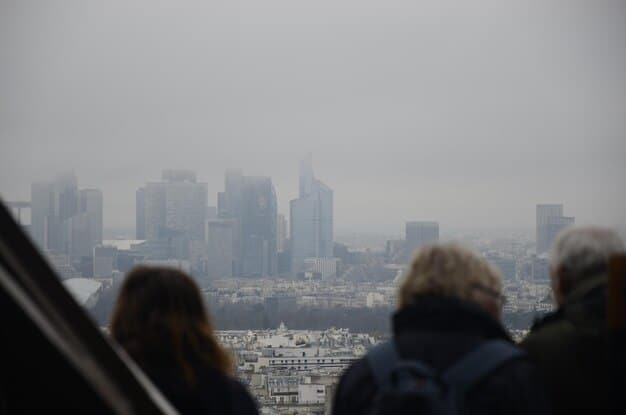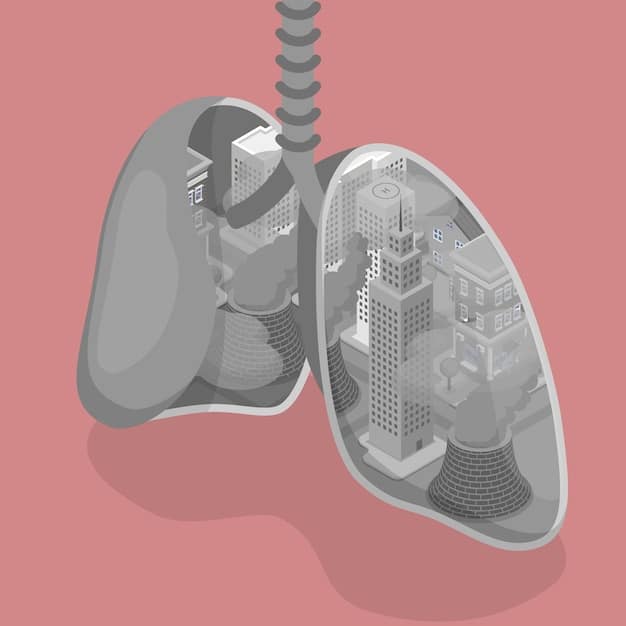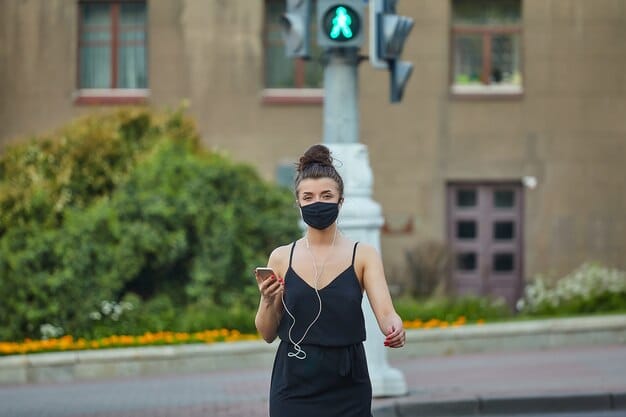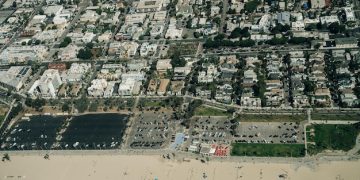Air Pollution & Respiratory Illnesses: New Study & Updated Guidelines in US

A groundbreaking study has revealed a significant link between air pollution and the rise of respiratory illnesses, leading to updated guidelines aimed at protecting public health in the United States.
A new study has brought to light a concerning correlation between air pollution and respiratory illnesses, leading to updated guidelines to address the growing threat to public health in the United States.
Breaking Down the New Air Pollution Study
A recent study has unveiled critical information regarding the impact of air pollution on respiratory health. This section will explore the key findings and methodologies used in the study.
The research, conducted over several years, focused on major metropolitan areas across the United States, analyzing the correlation between specific pollutants and the incidence of respiratory diseases. The results indicate a clear and alarming trend.
Key Findings of the Study
The study identified several pollutants as major contributors to respiratory problems:
- Particulate matter (PM2.5): Microscopic particles that can penetrate deep into the lungs.
- Ozone (O3): A gas formed by the reaction of sunlight with pollutants.
- Nitrogen dioxide (NO2): A byproduct of combustion from vehicles and industrial processes.
Researchers found that prolonged exposure to these pollutants significantly increased the risk of asthma, chronic bronchitis, and other respiratory conditions.

Methodology and Data Analysis
The study employed a rigorous methodology, combining air quality monitoring data with health records from participating hospitals and clinics. Statistical analysis revealed a direct link between high pollution levels and increased hospital admissions for respiratory ailments.
The data analysis also considered various demographic factors, such as age, socioeconomic status, and pre-existing health conditions, to provide a comprehensive understanding of the impact of air pollution on different populations.
In conclusion, this section highlighted the critical findings and methods of the new air pollution study, underlining the urgent need for updated guidelines to protect public health.
Updated Guidelines: A Response to the Growing Threat
In response to the concerning findings of the new study, updated guidelines have been issued to mitigate the impact of air pollution on respiratory health. Let’s examine these new recommendations and their potential implications.
These updated guidelines represent a significant step forward in addressing the growing threat of air pollution. They are designed to provide clear, actionable recommendations for reducing exposure and mitigating the harmful effects of pollutants.
Key Recommendations in the Updated Guidelines
The updated guidelines include several key recommendations for individuals, communities, and policymakers:
- Reduce exposure to air pollution by using air purifiers and wearing masks during high pollution days.
- Implement stricter regulations on industrial emissions and vehicle exhaust.
- Promote the use of public transportation and electric vehicles.
- Increase awareness and education about the health risks of air pollution.
By following these recommendations, individuals and communities can take proactive steps to protect their respiratory health and reduce the overall burden of air pollution.
Implications for Public Health
The updated guidelines have far-reaching implications for public health. By reducing exposure to air pollution, we can expect to see a decrease in the incidence of respiratory illnesses and improved overall health outcomes.
Furthermore, the guidelines emphasize the importance of addressing air pollution disparities, ensuring that vulnerable populations are not disproportionately affected by the health risks of pollutants.
Finally, these guidelines are a crucial response to the growing threat of air pollution, paving the way for a healthier and more sustainable future.
The Science Behind Air Pollution and Respiratory Illnesses
To fully understand the urgency of the new study and updated guidelines, it’s essential to delve into the science that connects air pollution to respiratory illnesses. Let’s explore the specific mechanisms by which pollutants affect the respiratory system.
At the core of the issue lies the way our bodies react to foreign particles and gases that enter our lungs. Extended exposure can cause lasting damage and respiratory issues.
How Air Pollution Harms the Lungs
Air Pollution is not only bad for visibility, it also has devastating effects on our vital respiratory organs:
- Inflammation: Pollutants can trigger inflammation in the lungs, leading to asthma and bronchitis.
- Oxidative stress: Exposure to pollutants can cause oxidative stress, damaging lung cells and impairing their function.
- Immune response: Air pollution can weaken the immune system, making individuals more susceptible to respiratory infections.
It’s crucial to understand these impacts for people to take air pollution seriously.
Specific Pollutants and Their Effects
Not all pollutants are created equal. Here’s how some specific pollutants affect our respiratory system:
Ozone irritates the airways, leading to coughing, wheezing, and shortness of breath. Particulate matter can penetrate deep into the lungs, causing inflammation and increasing the risk of respiratory infections. Nitrogen dioxide damages the lining of the lungs, making them more vulnerable to infection.
Better understanding these mechanisms, citizens can take measures to protect themselves and help bring awareness to society on a larger scale.
Practical Steps to Reduce Air Pollution Exposure
Protecting ourselves from air pollution requires practical strategies that can be implemented in our daily lives. Let’s explore how to minimize our exposure to pollutants and safeguard our respiratory health.
Reducing air pollution exposure can be as simple as making small, lifestyle modifications.

Personal Protective Measures
Wear Masks. Opt for high-quality masks like N95 or KN95, especially on high-pollution days.
Additionally, consider using air purifiers, particularly in homes and offices. Regular replacements of filters can significantly improve indoor air quality.
Community and Policy Involvement
Advocating for stricter environmental policies and regulations at the local and national level. Encourage the use of public transportation and electric vehicles.
By taking personal protective measures and engaging in community and policy involvement, we can collectively contribute to healthier and cleaner air for everyone.
The Role of Technology in Monitoring and Combating Air Pollution
Modern advancements in technology are playing a crucial role in monitoring and combating air pollution. Let’s explore how these tools are helping us understand and address this environmental challenge.
From advanced sensors to data analytics, technology is providing valuable insights into the sources and impacts of air pollution.
Air Quality Monitoring Technologies
There are new, increasingly smarter technologies for air monitoring. It is important to mention a few of them:
- Satellite monitoring: Satellites can provide a broad overview of air pollution levels over large areas.
- Sensor networks: Networks of ground-based sensors can provide real-time data on air quality in specific locations.
- Mobile apps: Smartphone apps can provide users with up-to-date information on air pollution levels in their area.
These technologies help to track pollution levels so we can identify pollution peaks and valleys throughout the day.
Data Analysis and Predictive Modeling
Data analysis and predictive modeling are essential tools for understanding and addressing air pollution. By analyzing historical data and trends, researchers can identify the sources of pollution and predict future levels.
This information can be used to develop targeted interventions and policies to reduce air pollution and protect public health.
These technologies offer powerful solutions for monitoring and combating air pollution to improve the quality of the air we breathe.
Global Perspectives: How Other Countries Are Tackling Air Pollution
Air pollution is a global issue, and different countries are implementing various strategies to address it. Let’s examine some examples of how other nations are tackling this challenge.
Learning from the experiences of other countries can provide valuable insights and inspiration for our own efforts to combat air pollution.
Success Stories and Innovative Approaches
Several countries have achieved notable success in reducing air pollution through innovative approaches. For example, some cities have implemented congestion pricing schemes to discourage car use, while others have invested heavily in public transportation.
There are cities building vertical forests in urban centers to reduce the footprint of pollution caused by cars, factories, and people in general.
Challenges and Lessons Learned
Despite these successes, many countries continue to face challenges in combating air pollution. Factors such as rapid urbanization, industrial growth, and limited resources can hinder progress.
By understanding these challenges and learning from the lessons of others, we can develop more effective strategies to protect our own communities from the harmful effects of air pollution.
| Key Point | Brief Description |
|---|---|
| 🔬 Study Findings | Air pollution linked to respiratory illness increase. |
| ✍ Updated Guidelines | Recommendations to reduce pollution exposure. |
| 💪 Personal Actions | Use masks/purifiers, support clean policies. |
| 🌐 Global Efforts | Countries tackling pollution with various strategies. |
Frequently Asked Questions
▼
The study identified particulate matter (PM2.5), ozone (O3), and nitrogen dioxide (NO2) as the main pollutants contributing to respiratory illnesses.
▼
You can reduce your exposure by using air purifiers, wearing masks on high-pollution days, and supporting policies promoting clean air.
▼
The updated guidelines provide recommendations for individuals, communities, and policymakers to reduce air pollution exposure and mitigate its harmful effects.
▼
Technology plays a crucial role through satellite monitoring, sensor networks, and mobile apps that provide real-time data on air quality levels.
▼
This research raises awareness about the dangers of pollution and these new guidelines are intended to show people how to take steps to protect themselves from these hazards.
Conclusion
The alarming findings of the new study linking air pollution and respiratory illnesses underscore the urgent need for action. By understanding the science behind this connection, implementing practical protective measures, and supporting policies that promote clean air, we can collectively mitigate the impact of air pollution and safeguard public health for generations to come.





